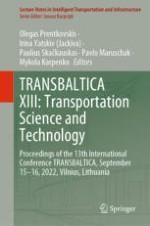2023 | Buch
TRANSBALTICA XIII: Transportation Science and Technology
Proceedings of the 13th International Conference TRANSBALTICA, September 15-16, 2022, Vilnius, Lithuania
herausgegeben von: Olegas Prentkovskis, Irina Yatskiv (Jackiva), Paulius Skačkauskas, Pavlo Maruschak, Mykola Karpenko
Verlag: Springer International Publishing
Buchreihe : Lecture Notes in Intelligent Transportation and Infrastructure
